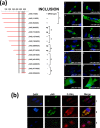Avian reovirus microNS protein forms homo-oligomeric inclusions in a microtubule-independent fashion, which involves specific regions of its C-terminal domain
- PMID: 20181708
- PMCID: PMC2863718
- DOI: 10.1128/JVI.02534-09
Avian reovirus microNS protein forms homo-oligomeric inclusions in a microtubule-independent fashion, which involves specific regions of its C-terminal domain
Abstract
Members of the genus Orthoreovirus replicate in cytoplasmic inclusions termed viral factories. Compelling evidence suggests that the nonstructural protein microNS forms the matrix of the factories and recruits specific viral proteins to these structures. In the first part of this study, we analyzed the properties of avian reovirus factories and microNS-derived inclusions and found that they are nonaggresome cytoplasmic globular structures not associated with the cytoskeleton which do not require an intact microtubule network for formation and maturation. We next investigated the capacity of avian reovirus microNS to form inclusions in transfected and baculovirus-infected cells. Our results showed that microNS is the main component of the inclusions formed by recombinant baculovirus expression. This, and the fact that microNS is able to self-associate inside the cell, suggests that microNS monomers contain all the interacting domains required for inclusion formation. Examination of the inclusion-forming capacities of truncated microNS versions allowed us to identify the region spanning residues 448 to 635 of microNS as the smallest that was inclusion competent, although residues within the region 140 to 380 seem to be involved in inclusion maturation. Finally, we investigated the roles that four different motifs present in microNS(448-635) play in inclusion formation, and the results suggest that the C-terminal tail domain is a key determinant in dictating the initial orientation of monomer-to-monomer contacts to form basal oligomers that control inclusion shape and inclusion-forming efficiency. Our results contribute to an understanding of the generation of structured protein aggregates that escape the cellular mechanisms of protein recycling.
Figures








Similar articles
-
A versatile molecular tagging method for targeting proteins to avian reovirus muNS inclusions. Use in protein immobilization and purification.PLoS One. 2010 Nov 12;5(11):e13961. doi: 10.1371/journal.pone.0013961. PLoS One. 2010. PMID: 21103063 Free PMC article.
-
Mammalian reovirus nonstructural protein microNS forms large inclusions and colocalizes with reovirus microtubule-associated protein micro2 in transfected cells.J Virol. 2002 Aug;76(16):8285-97. doi: 10.1128/jvi.76.16.8285-8297.2002. J Virol. 2002. PMID: 12134034 Free PMC article.
-
Avian reovirus nonstructural protein microNS forms viroplasm-like inclusions and recruits protein sigmaNS to these structures.Virology. 2004 Feb 5;319(1):94-106. doi: 10.1016/j.virol.2003.10.034. Virology. 2004. PMID: 14967491
-
Early steps in avian reovirus morphogenesis.Curr Top Microbiol Immunol. 2006;309:67-85. doi: 10.1007/3-540-30773-7_3. Curr Top Microbiol Immunol. 2006. PMID: 16909897 Review.
-
Function, Architecture, and Biogenesis of Reovirus Replication Neoorganelles.Viruses. 2019 Mar 21;11(3):288. doi: 10.3390/v11030288. Viruses. 2019. PMID: 30901959 Free PMC article. Review.
Cited by
-
IC-tagging and protein relocation to ARV muNS inclusions: a method to study protein-protein interactions in the cytoplasm or nucleus of living cells.PLoS One. 2010 Nov 2;5(11):e13785. doi: 10.1371/journal.pone.0013785. PLoS One. 2010. PMID: 21072177 Free PMC article.
-
A versatile molecular tagging method for targeting proteins to avian reovirus muNS inclusions. Use in protein immobilization and purification.PLoS One. 2010 Nov 12;5(11):e13961. doi: 10.1371/journal.pone.0013961. PLoS One. 2010. PMID: 21103063 Free PMC article.
-
The non-structural protein μNS of piscine orthoreovirus (PRV) forms viral factory-like structures.Vet Res. 2016 Jan 8;47:5. doi: 10.1186/s13567-015-0302-0. Vet Res. 2016. PMID: 26743679 Free PMC article.
-
Aquareovirus NS80 Initiates Efficient Viral Replication by Retaining Core Proteins within Replication-Associated Viral Inclusion Bodies.PLoS One. 2015 May 4;10(5):e0126127. doi: 10.1371/journal.pone.0126127. eCollection 2015. PLoS One. 2015. PMID: 25938226 Free PMC article.
-
Structure and function of S9 segment of grass carp reovirus Anhui strain.Virusdisease. 2017 Mar;28(1):26-32. doi: 10.1007/s13337-016-0357-1. Epub 2017 Jan 16. Virusdisease. 2017. PMID: 28466052 Free PMC article.
References
-
- Attoui, H., F. Billoir, P. Biagini, P. de Micco, and X. de Lamballerie. 2000. Complete sequence determination and genetic analysis of Banna virus and Kadipiro virus: proposal for assignment to a new genus (Seadornavirus) within the family Reoviridae. J. Gen. Virol. 81:1507-1515. - PubMed
-
- Bodelon, G., L. Labrada, J. Martinez-Costas, and J. Benavente. 2001. The avian reovirus genome segment S1 is a functionally tricistronic gene that expresses one structural and two nonstructural proteins in infected cells. Virology 290:181-191. - PubMed
Publication types
MeSH terms
Substances
LinkOut - more resources
Full Text Sources
Other Literature Sources

